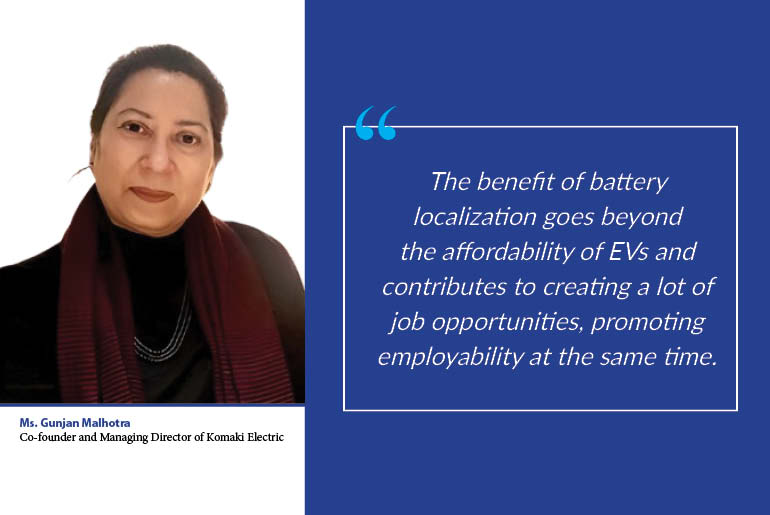Electric vehicles have gained a lot of traction in recent years. With the world making significant strides to curb carbon emissions, EVs have emerged as the most suitable option, driving the paradigm shift toward clean transportation. Following the league, even India registered a whopping sale of 1,69,931 units in the month of January 2025 itself, as per the IBEF report.
The EV industry has been making steady progress toward achieving the ambitious target of reaching 30% of new private vehicle registrations by 2030. On the other hand, even India is determined to become an EV-first nation by the same year. However, in order to achieve the ambitious goal, it is more important than ever to bring about battery localization to expedite the process of EV adoption among the potential consumers.
Battery localization can give the desired impetus to the deeper penetration of EVs across the country. Abiding by the ‘Make in India’ initiative, it can go a long way in reducing the overall cost of electric vehicles. The upfront cost of EVs being on the expensive side as compared to ICE vehicles deters potential consumers from purchasing the vehicle. Thereby, boosting battery localization comes with the added advantage of improving the affordability of electric vehicles. This, in turn, plays a crucial role in mitigating the initial obstacle of price, which intimidates customers from buying the vehicle.
Looking at the role of battery localization in shrinking the cost of EVs, the article explores the host of factors that contribute to the affordability of the vehicles.
1) Elimination of import duties and taxes
Batteries account for around 40 percent of the overall EV price, and at present India depends heavily on imports of batteries from other countries. The high import duties invariably spike the price of the batteries, which is subject to battery type and trade agreement. Responsible for shooting the price of EVs in the process, manufacturing the batteries indigenously plays a significant role in mitigating the import taxes, bringing down the vehicle cost by a huge margin.
2) Capping the supply chain cost
Setting up battery manufacturing facilities within the country reduces the dependence on other countries for imports. Likewise, it also cuts down the complex and long supply chain involved in the process that is responsible for contributing to the multiple hidden costs in addition to the product price. This could include multiple costs such as shipping charges, logistics costs, etc. Furthermore, considering that batteries come under hazardous goods, they are subject to high insurance premiums for international transportation. Similarly, the fluctuating currency rates also impact the pricing and margins of the batteries. Not to mention the customs clearance costs and inventory holding costs that further skyrocket the price of the batteries.
On the contrary, producing batteries locally drastically shortens the distance of transportation and, consequently, minimizes the cost of batteries. Additionally, domestic logistics and insurance costs are much cheaper and simpler as compared to international transportation. At the same time, the agility in moving the goods from one destination to the other invariably lowers the inventory cost. Plying within the country, there is minimal risk of currency fluctuations. Altogether, by promoting battery localization, industry can avoid the surplus charges that would have gone into importing the battery from overseas.
3) Improved accessibility to raw material
Domestic manufacturing comes with the added advantage of easier accessibility to raw materials. With the government pushing efforts to identify sites with critical minerals like lithium, nickel, cobalt, manganese, graphite, etc., it aims to minimize imports from international markets. Procuring raw materials indigenously, and that too from government-backed deals, plays a crucial role in bringing down the cost as compared to that of open-market imports. Given to the proximity to raw materials, there is stability in pricing and enhancement in supply security at the same time.
4) Support from government incentives
To expedite the process of EV adoption, the government is continuously coming up with proactive efforts in the form of incentives, PLI schemes, and subsidies to facilitate battery manufacturing within the country. The lower cost of manufacturing batteries ultimately translates to the affordability of EVs in the long run.
The benefit of battery localization goes beyond the affordability of EVs and contributes to creating a lot of job opportunities, promoting employability at the same time. Thereby, creating a robust line of domestic battery manufacturing not only reduces the cost of vehicles but also comes to aid in monitoring the quality of the battery in the process. Moreover, it is a significant move in alleviating the initial intimidation of customers discouraging them from buying EVs on account of their upfront cost.

